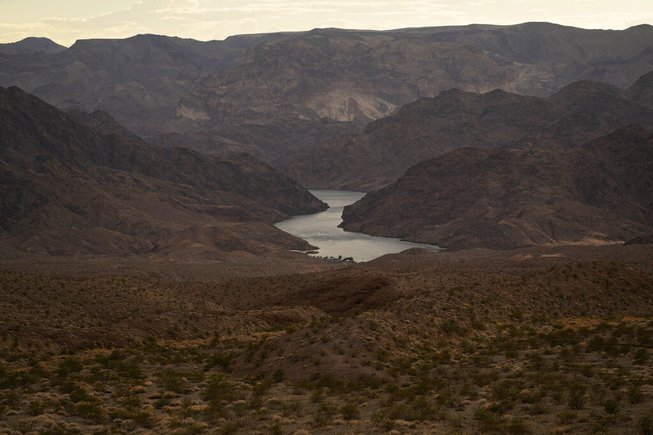
John Locher / AP
Water flows down the Colorado River downriver from Hoover Dam in northwest Arizona, on Aug. 14, 2022, near the Lake Mead National Recreation Area.
Monday, Jan. 8, 2024 | 2 a.m.
WASHINGTON — The states that rely on the Colorado River, which is shrinking because of climate change and overuse, are rushing to agree on a long-term deal to share the dwindling resource by the end of the year. They worry that a change in administrations after the election could set back talks.
Negotiators are seeking an agreement that would prepare for extraordinary cuts in the amount of river water that can be tapped. The Colorado provides drinking water to 40 million people in seven states, 30 tribes and Mexico, as well as irrigation for some of America’s most productive farmland.
But the amount of water flowing in the Colorado has declined over time as rising temperatures reduce the snowpack that feeds the river.
“How do we live with the river that we have, not the river that we hope and dream for?” said Becky Mitchell, lead negotiator for the state of Colorado.
The rules that govern the distribution of Colorado River water expire at the end of 2026. Negotiators are trying to reach a deal quickly, in case the White House changes hands. It’s not the prospect of a Republican administration that is particularly concerning, negotiators said, but rather a change in personnel and the time required to build new relationships between state and federal officials.
“Whenever there’s an administration change, that significantly disrupts things,” said JB Hamby, chair of the Colorado River Board of California and that state’s lead negotiator. “If we can get a draft ready and in place by the end of the year, that will ensure that we get the hard work done.”
The Colorado River hit a crisis a year and a half ago, when dangerously low water levels threatened the water supply for California, Arizona and Nevada, prompting the Biden administration to seek an agreement among states on deep cuts. That crisis receded after last year’s unusually wet winter, which temporarily reduced pressure on the river; in May, California, Arizona and Nevada agreed to more modest reductions than what the government had initially sought.
But those negotiations were a precursor to a much harder challenge. Whatever agreement replaces the current rules will require far deeper reductions than in the past.
“We all have to live within our means,” said Adel Hagekhalil, general manager of the Metropolitan Water District of Southern California, the largest wholesale drinking water supplier in the country, which gets half its water from the Colorado River. The challenge, he said, “is figuring out how we’re going to share.”
Those negotiations are taking place against the backdrop of scant snowfall so far this winter. On Tuesday, California reported that its snowpack was just one-fourth of the average level for this point in the season. Monitoring sites across the Colorado River basin report snow measurements that are less than half their usual levels.
That below-average snowfall “has reinforced that you can potentially have a bad year after a good year,” said Tom Buschatzke, director of Arizona’s Department of Water Resources and the state’s lead negotiator in the talks. “The dry conditions that are leading to a decline in the flow of the river are probably our long-term future."
Time is short to reach an agreement. The federal agency in charge of the Colorado River, the Bureau of Reclamation, has asked states to propose an agreement by early March, so that the department can issue draft regulations by December — weeks before Inauguration Day.
Even if the Biden administration stays in office, finalizing the new rules before the current agreement expires at the end of 2026 will require moving quickly, according to Buschatzke.
That gives states just two months to decide a wide range of questions, including what level of water reductions they should plan for, based on how much the flow of the Colorado might shrink during the course of the deal.
Still, negotiators say they’re optimistic about reaching an agreement. Part of the reason is the significant federal spending on new infrastructure to use water more efficiently, which makes it easier to absorb cuts, according to Camille Touton, commissioner of the Bureau of Reclamation.
She pointed to investments such as water recycling in the Gila River Indian Community, south of Phoenix, which returns water to the Colorado River system.
“Funding from the Biden administration allowed us not just to plan for rainy days,” Touton said in an interview. “This is our plan in case it didn’t rain.”
But even with those investments, states throughout the Southwest will need to absorb huge cuts in water use. Las Vegas, which depends on water from the Colorado River, recently outlawed lawns, which account for a significant portion of municipal water use. The city has also imposed a moratorium on evaporative cooling in new buildings, in favor of other types of air conditioning that use less water.
John Entsminger, head of the Southern Nevada Water Authority and his state’s lead negotiator in the talks, said other cities and states in the basin would need to adopt similar degrees of change.
“It’s going to be difficult,” Entsminger said. “But it can be done.”
This article originally appeared in The New York Times.
